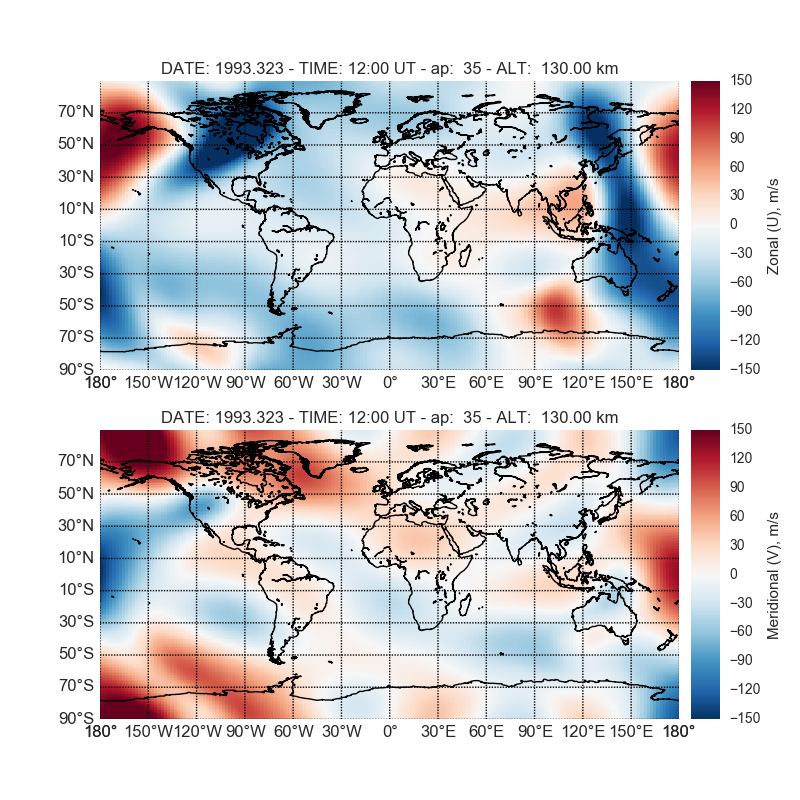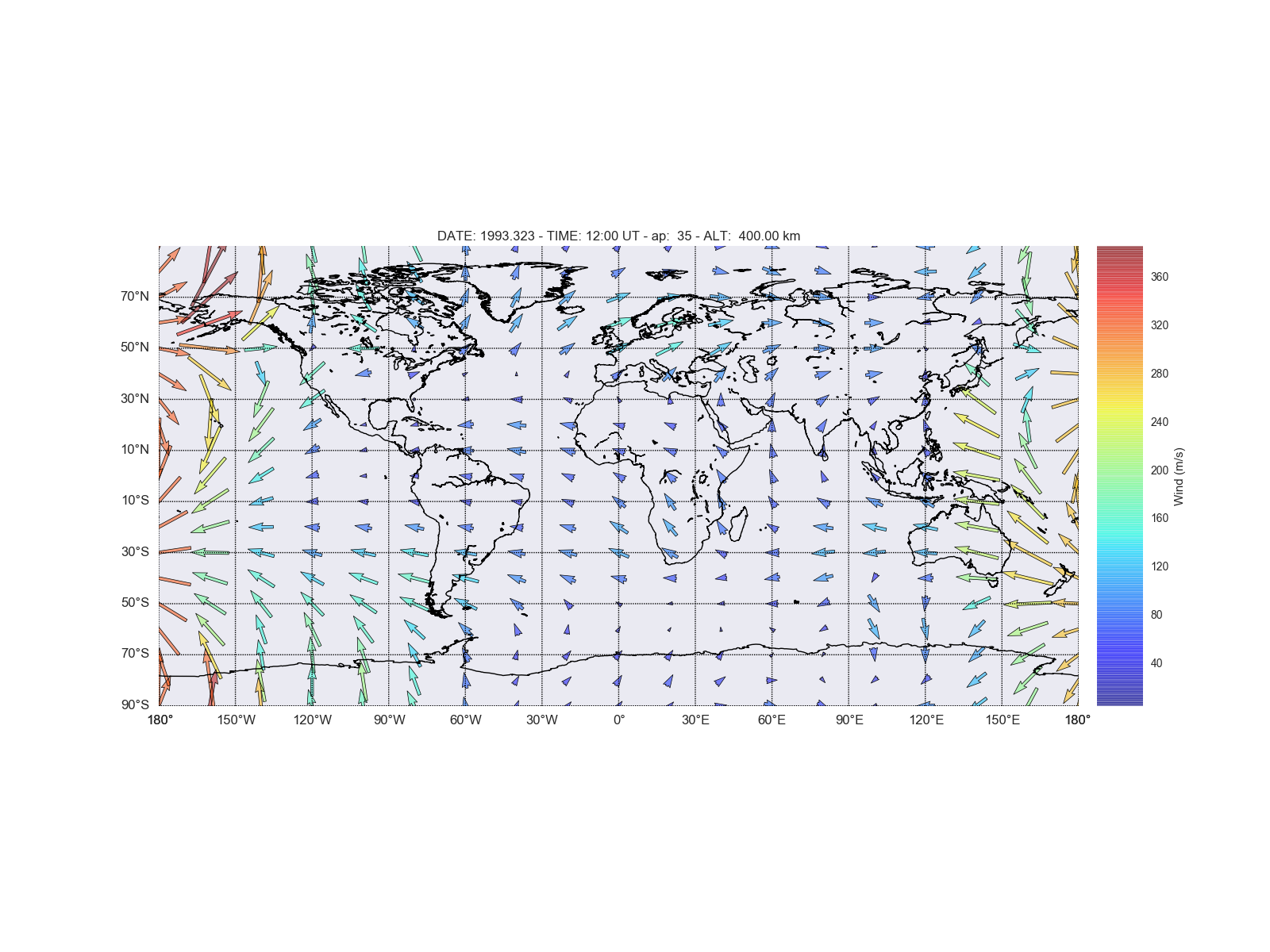pyHWM14
Python interface for the Horizontal Wind Model version 2014 (HWM14)
Contents
Installation
From Source Code
Currently supports Python 3.10 (see Github Actions)
$ git clone https://github.com/rilma/pyHWM14.git
$ cd pyHWM14
$ make installFrom PyPi
pip install pyhwm2014
Testing
$ make testExamples
You will need seaborn (the statistical data visualization package) in order to run the following examples.
$ pip install seabornHeight Profile
>>> from pyhwm2014 import HWM14, HWM14Plot
>>> hwm14Obj = HWM14( altlim=[90,200], altstp=1, ap=[-1, 35], day=323,
option=1, ut=11.66667, verbose=False, year=1993 )
>>> hwm14Gbj = HWM14Plot( profObj=hwm14Obj )You can also list the values on screen as follows
>>> from pyhwm2014 import HWM14
>>> hwm14Obj = HWM14( altlim=[90,200], altstp=10, ap=[-1, 35], day=323,
option=1, ut=11.66667, verbose=True, year=1993 )
HEIGHT PROFILE
quiet disturbed total
alt mer zon mer zon mer zon
90 11.112 28.727 -0.001 -0.000 11.112 28.726
100 26.762 6.705 -0.007 -0.006 26.755 6.700
110 -40.361 1.468 -0.080 -0.066 -40.442 1.402
120 -15.063 -16.198 -0.777 -0.640 -15.840 -16.838
130 5.352 -28.597 -2.713 -2.233 2.639 -30.829
140 -7.310 -28.295 -3.410 -2.806 -10.720 -31.101
150 -23.281 -26.597 -3.484 -2.867 -26.765 -29.464
160 -34.557 -20.983 -3.490 -2.872 -38.047 -23.855
170 -40.041 -13.405 -3.491 -2.872 -43.531 -16.277
180 -37.589 -12.893 -3.491 -2.872 -41.080 -15.765
190 -29.611 -18.405 -3.491 -2.872 -33.102 -21.278
200 -19.680 -26.278 -3.491 -2.872 -23.171 -29.150Geog. Latitude Profile
>>> from pyhwm2014 import HWM14, HWM14Plot
>>> hwm14Obj = HWM14( alt=130., ap=[-1, 35], day=323, glatlim=[-90.,90.],
glatstp=1., option=2, ut=11.66667, verbose=False, year=1993 )
>>> hwm14Gbj = HWM14Plot( profObj=hwm14Obj )GMT Profile
>>> from pyhwm2014 import HWM14, HWM14Plot
>>> hwm14Obj = HWM14( alt=130., ap=[-1, 35], day=323,
option=3, utlim=[0., 23.45], utstp=.25, verbose=False, year=1993 )
>>> hwm14Gbj = HWM14Plot( profObj=hwm14Obj )Geog. Longitude Profile
>>> from pyhwm2014 import HWM14, HWM14Plot
>>> hwm14Obj = HWM14( alt=130., ap=[-1, 35], day=323, glonlim=[-180., 180.], glonstp=2.,
option=4, verbose=False, year=1993 )
>>> hwm14Gbj = HWM14Plot( profObj=hwm14Obj )Height vs GMT
>>> from pyhwm2014 import HWM142D, HWM142DPlot
>>> hwm14Obj = HWM142D(altlim=[90,200], altstp=2, ap=[-1, 35],
option=1, utlim=[0.,23.75], utstp=.25, verbose=False)
>>> hwm14Gbj = HWM142DPlot(profObj=hwm14Obj, zMin=[-75., -100], zMax=[75., 100.])Height vs Geog. Latitude
>>> from pyhwm2014 import HWM142D, HWM142DPlot
>>> hwm14Obj = HWM142D(altlim=[90., 200.], altstp=2., ap=[-1, 35],
glatlim=[-90., 90.], glatstp=2., option=2, verbose=False, ut=12.)
>>> hwm14Gbj = HWM142DPlot(profObj=hwm14Obj, zMin=[-250., -100], zMax=[250., 100.])Height vs Geog. Longitude
>>> from pyhwm2014 import HWM142D, HWM142DPlot
>>> hwm14Obj = HWM142D(altlim=[90., 200.], altstp=1., ap=[-1, 35],
glonlim=[-90., 90.], glonstp=2., option=4, ut=12., verbose=False)
>>> hwm14Gbj = HWM142DPlot(profObj=hwm14Obj, zMin=[-100., -100], zMax=[100., 100.])Geog. Latitude vs Geog. Longitude
>>> from pyhwm2014 import HWM142D, HWM142DPlot
>>> hwm14Obj = HWM142D(alt=130., ap=[-1, 35], glatlim=[-90., 90.],
glatstp=1., glonlim=[-180., 180.], glonstp=2., option=6, verbose=False)
>>> hwm14Gbj = HWM142DPlot(profObj=hwm14Obj, zMin=[-150., -150], zMax=[150., 150.])Horizontal Wind Field Map
>>> from pyhwm2014 import HWM142D, HWM142DPlot
>>> hwm14Obj = HWM142D(alt=400., ap=[-1, 35], glatlim=[-90., 90.], glatstp=10.,
glonlim=[-180., 180.], glonstp=20., option=6, verbose=False)
>>> hwm14Gbj = HWM142DPlot( profObj=hwm14Obj, WF=True, zMin=[-150., -150],
zMax=[150., 150.] )References
| [1] | Peterson, P. "F2PY: Fortran to Python interface generator" |
| [2] | Drob, D. P. et al. "An update to the Horizontal Wind Model (HWM): The quiet time thermosphere", Earth and Space Science, 2015 |
Wrapping Fortran code
This is for reference, no need to do this as it's done by python setup.py develop
1. The first step is to ask 'f2py' to write the signature of the routine (hwm14.f90) to a description file
$ f2py hwm14.f90 -m hwm14 -h hwm14.pyfThe '-m' flag gives the name the python module should have (hwm14). The '-h' flag tells 'f2py' in which file should write the signature (see file 'hwm14.pyf').
2. 'f2py' recognizes which variables need to be passed in or out. This is done by the command 'intent' added to the declaration of variables.
3. Now everything is ready and the module can be compiled. f2py will try to find a compiler in your path and use it. So all to be typed is
$ f2py -c hwm14.pyf hwm14.f90'f2py' will write the wrapper files, compile hwm14.f90 and the wrapper files, and link them in a shared object. After this step, one can start Python and load the extension module.
NOTE: To specify a Fortran compiler type by vendor, e.g. ifort (Intel Fortran compiler):
$ f2py -c hwm14.pyf hwm14.f90 --fcompiler=intelem







